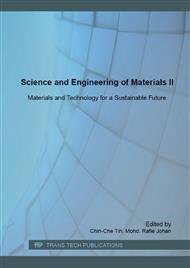p.143
p.148
p.154
p.159
p.164
p.177
p.182
p.187
p.195
Investigation on the Effect of Crystal Orientation Dependence of Pulse Porous Silicon for White Light Emission
Abstract:
Porous silicon (PS) was formed by using an electrochemical pulse etching (PC) and conventional direct current (DC) etching techniques. The study aims to compare the effect of crystal orientations (n-type (100) and n-type (111)) on the formation of the PS under various conditions. For DC etching technique, the silicon wafers were etched in Hydrofluoric (HF) based solution with a current density of J=10 mA/cm2 for 30 minutes. While for the PC process, an electroless chemical etching with a different delay time (Td) of 0 min and 2 min were imposed before PC process starts. After that, the pulse current of J=10 mA/cm2 with the cycle time (T) of 10 ms and pause time (Toff) of 4ms were supplied in 30 min etching time in HF based electrolyte. Three samples from n-type (100) are DC1, PC1 and PC2 while the three samples from n-type (111) are DC2, PC3, and PC4 respectively. Field Emission Scanning Electron Microscopy (FESEM) images showed that the samples from n-type (100) produce more uniform circular structures and dense compared to n-type (111). The introduction of 2 minutes delay during PC process resulted in better structural of PS formation and also the optical properties shown by the Raman and Photoluminescence (PL) spectroscopies. For PL observation, the as grown Si shows no emission at the visible spectrum while all the PS samples (DC and PC techniques) exhibited significant broad spectrum between 500 nm to 900 nm respectively. It can be seen that the uniform circular pore of n-type (100) enhanced the PL emission indicated by the higher PL intensity (PC1 and PC2) compared to PC3 and PC4 from n-type (111). Raman spectroscopy showed that an improvement in the crystalline quality of PS in PC technique compared to DC indicated by the reduction of full width at half maximum (FWHM).
Info:
Periodical:
Pages:
164-176
Citation:
Online since:
July 2016
Price:
Сopyright:
© 2016 Trans Tech Publications Ltd. All Rights Reserved
Share:
Citation:


